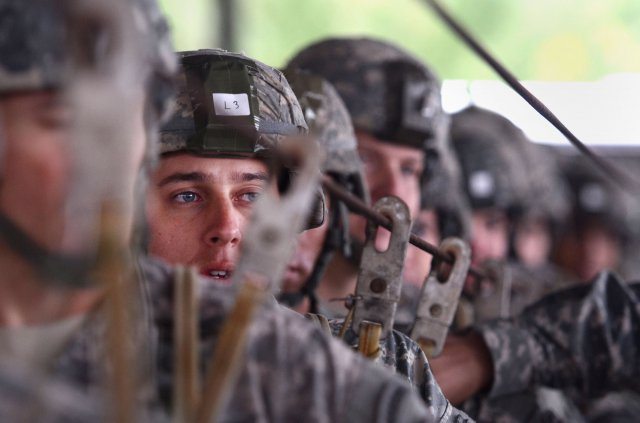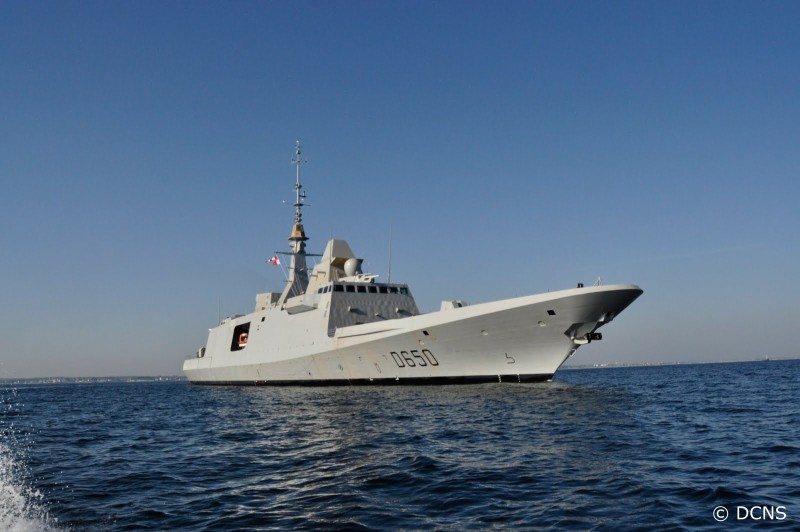After 36 hours at Pope Army Airfield, double-checking their gear and rehearsing their mission, nearly 1,300 paratroopers took off into the night Oct. 9, on board 21 C-130 and C-17 aircraft.
The Falcon Brigade paratroopers were headed to Fort Polk, for a month-long decisive action training exercise to hone their skills. The paratroopers are ready for any mission, real-world or not, said Col. Patrick Hynes, commander of the 82nd Airborne Division’s 2nd Brigade Combat Team, also known as the Falcon Brigade.
This is the first time since 2002 that a unit left Fort Bragg to conduct a forcible-entry mission to carry out force-on-force training operations at the Joint Readiness Training Center on Fort Polk, Hynes said.
“We’re the only unit in the Army that can do this right now,” he added. “The Army needs to be able to project power rapidly to potentially contested areas. For that reason you need a forcible-entry force, and that’s really what the 82nd Airborne Division brings as the Global Response Force.”
NEW MISSION
For more than a decade, counter-insurgency has been at the heart of the division’s and Army’s training efforts. But with combat operations in Iraq over, and the U.S. military footprint in Afghanistan expected to draw down in 2014, the division is shifting its focus.
The division, which recently returned from a year-long deployment to southern Afghanistan, is responsible for maintaining an airborne combat brigade as part of the nation’s Global Response Force, or GRF.
While the Army begins to gradually align brigade combat teams and divisions regionally with combatant commands, the 82nd Airborne Division will remain flexible to serve in any theater of operation. The 2nd Brigade, centered around the 325th Airborne Infantry Regiment, assumes this role from the division’s 3rd Brigade Combat Team in the coming months.
“[The GRF] is a mission we’ve had before and, indeed, to some extent, we’ve never lost,” Maj. Gen. John W. Nicholson said in a ceremony Oct. 4, when he took command of the division. “It’s one we had for four decades prior to 9/11. That is the mission of the Global Response Force, to be ready to deploy anytime, anywhere around the globe by forcible entry, if required, to accomplish our nation’s objectives.”
The year-long mission calls for the brigade and its paratroopers to maintain a high state of readiness in order to deploy worldwide by air-landing or parachute assault within 18 hours of notification.
“As the GRF, you have to understand the threats and strategic requirements that the nation is responsible for,” said Lt. Col. Erik Berdy, commander of the brigade’s 2nd Battalion, 325th Airborne Infantry Regiment. “That’s why we train the way we do.”
TRAINING
The brigade is at the Joint Readiness Training Center on Fort Polk through Oct. 26. While 1,300 paratroopers parachuted in or air-landed for the initial phase of the operation, the majority of Soldiers have been on the ground since Sept. 30, honing their specialty skills on live-fire ranges and setting the stage for the airborne assault.
About 4,000 Soldiers, including the Falcon Brigade and 82nd Sustainment Brigade from Fort Bragg, N.C.; the 7th Special Forces Group from Eglin Air Force Base, Fla.; and the 101st Airborne Division’s 4th Battalion, 101st Aviation Regiment,from Fort Campbell, Ky., are participating in the joint exercise. Almost an additional 800 service members from throughout the military stationed as far away as Hawaii are involved.
Once on the ground, amid the chaos and darkness, the paratroopers placed their weapons into operation, mustered their ranks and began to tackle the uncertainty of the next phases of their mission, airfield seizure and defensive operations. The paratroopers worked throughout the night in order to maintain security of the airfield and build combat power to conduct operations against a battalion-size enemy force.
Rather than training to relieve a specific unit in Iraq or Afghanistan, the brigade’s paratroopers are readying themselves to face a combination of threats, including guerrilla warfare, insurgents, criminals, and conventional forces. The brigade is also ready to provide humanitarian assistance and rescue noncombatants, Hynes said.
“The threats are more layered,” he said. “There’s an irregular and conventional component. So there’s a lot of uncertainty in the scenario here.”
Berdy recalled his days as a young lieutenant in Haiti with the same battalion. He compared that mission in 1994 to the mission set his paratroopers are honing today nearly 20 years later.
“We were there to provide humanitarian [and] peace-keeping assistance, and we were also dealing with a legitimate threat,” Berdy explained. “We were dealing with criminal activity who were shooting at us somewhat regularly. There was also plenty that we were doing that is similar to [fighting] a counterinsurgency.
“It just shows the flexibility of the American Soldier, and, in this case, the American paratrooper,” he added.
The Fort Polk training is realistic and based on what the U.S. considers global security threats, Army Lt. Col. Kevin Quarles said, lauding the observer controllers and planners at the training center.
“The Falcon Brigade owes a debt of gratitude to the incredible team at JRTC for providing the most challenging and realistic training environment that we have ever encountered,” Quarles, the brigade’s deputy commander, said. “The world-class mentorship provided by the observer controller-trainers and their dedication to ensuring the Brigade’s training objectives were met has significantly contributed to the Falcon Brigade’s readiness.”
Although he would not speculate on specific situations, Quarles suggested that the training is not simply a reflection of security issues in the Middle East. The brigade, he said, is preparing for an array of missions that could include counterinsurgency, conventional warfare, guerrilla warfare, and humanitarian assistance.
“We’re getting a good look at the full spectrum of potential operational challenges that are typical of [security issues] going on in the world today,” Quarles said. “Whether it’s 18 hours or 96 hours, we’re trained, ready, and flexible to rapidly deploy to unstable areas to protect American interest.”
SOLDIER CHALLENGES
Command Sgt. Maj. Jason Mosher said the biggest challenge for his Soldiers is to “get out of the FOB [Forward Operating Base] mentality.” If the brigade is called on during its time as the GRF, it could deploy to a location that has not recently had American Soldiers on the ground. That’s a stark difference for many Soldiers deployed to Iraq and Afghanistan the past few years.
“It’s not like Iraq or Afghanistan where you’re replacing another unit and falling in on their gear and living areas,” Mosher, the senior-enlisted adviser for the Brigade Special Troops Battalion, said. “It’s not there unless you brought it on your back. There is no living trailer with an air conditioner or contracted laundry facility.”
Getting Soldiers to understand that a forward operating base, or FOB, may not be there waiting on them was one of the biggest challenges leading up to the Joint Readiness Training Center exercise, Mosher said. However, after several weeks in the field over the past three months prior to JRTC, his Soldiers have adjusted well to the new mission.
“Our progressive training, with our battalion and brigade field exercises, was kind of an eye-opener,” he said. “The first was hard, and the next was hard, but not as hard. But by the time we get to JRTC, there shouldn’t be near as much grumbling, and Soldiers will be able to better focus on the fight.”
Staff Sgt. Christopher Zamudio, an infantryman and jumpmaster with the brigade’s Company C., 1st Battalion, 325th Airborne Infantry Regiment, said this type of mission is what he’s been training for his entire career. The Iraq war veteran is confident that he and his paratroopers will be able to adjust quickly to any mission.
“It’s too easy,” he said. “Every time we have a training exercise, we step it up a notch to make it more realistic. Yes, we’re airborne, but once we hit the ground, we’re ready for whatever the enemy has in store.”
Zamudio’s pride in his airborne roots stems from even before he enlisted. As a teenager, he often watched documentaries and movies of 82nd paratroopers in World War II. He was inspired by the tradition and lineage, he said.
“I pride myself on being able to take on this new mission, just like past 82nd paratroopers,” he said. “That’s what I try to portray to my men, you are a part of an elite unit with a strong history and legacy, but you want to be able to put that into execution successfully yourself.”
The brigade is made up of about 3,500 paratroopers. The brigade consists of six battalions, including the 1st and 2nd battalions, 325th Airborne Infantry Regiment; the 1st Squadron, 73rd Cavalry Regiment; 2nd Battalion, 319th Field Artillery Regiment, 2nd Brigade Special Troops Battalion; and the 407th Brigade Support Battalion.











